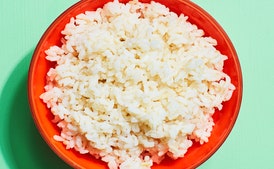
Cooked Semi-Polished Rice (Haiga Mai)
['1 cup Japanese-style semi-polished rice', '1 cup plus 3 tablespoons water, soft tap or filtered', '1 1/2 cups Japanese-style semi-polished rice', 'Generous 1 3/4 cups', 'soft tap or filtered water']

As already noted, great care must be taken when washing partially polished rice to avoid dislodging the nutrient-rich germ. Place the rice in a deep bowl and pour in enough cool tap water just to cover the grains. Using your fingertips in gentle swirling, swishing motions, rinse the grains for about 15 seconds. With slightly scooping motions, gently lift the grains once or twice, to ensure that water flows freely around each grain. Drain the rice. Use your hand or a fine-mesh strainer to hold back the rice as you drain off the water. Some people find it useful to line their strainer with fine-woven cloth (the Japanese use sarashi) or a clean, low-lint kitchen towel. Carefully transfer the rice to a pot or rice-cooker bowl.
Place the washed and drained rice in a sturdy, straight-sided pot. A 2- or 3-quart size will work well for the two smaller quantities, and a 4- to 6-quart pot is appropriate for the larger amount. Add the water. Ideally, the rice should sit in its measured water for 10 minutes before cooking, but if you are pressed for time, add a few extra drops of water and cook right away. Cover the pot with a tight-fitting lid.
Bring the water to a rolling boil over high heat. You will hear bubbling noises and see the lid begin to dance after several minutes. An onomatopoeic folk jingle that describes the cooking of rice refers to this bubbling stage as choro choro. Reduce the heat and continue to cook until the water is absorbed (about 5 minutes). You will know this point has been reached when you hear a low hissing sound (the folk jingle calls this naka pappa). If it is difficult to rely on the sound of the cooking and you must check visually on progress along the way, peek quickly, replacing the lid immediately.
Increase the heat to high again for 30 seconds to dry off the rice. Remove the pot from the heat and let the rice stand, still tightly covered, for at least 10 minutes. Even if you wish to serve the rice piping hot, these final minutes of self-steaming (called murasu) are necessary to achieve the proper texture.
Place the washed and drained rice in the bowl of your cooker. Add the water. It is important to use cool liquid when cooking rice in a thermostatically controlled appliance; using warm or hot liquid from the start will cut short the cooking cycle. Close the lid, press the start switch, and let the appliance do the cooking. The time required to complete the cooking cycle will vary with the appliance, but most models take about 40 minutes to cook 1 to 1 1/2 cups raw rice.
Attribution for Recipes (CC BY-SA 3.0):
The recipes displayed in this app have been crated using content available under the Creative Commons Attribution-ShareAlike 3.0 Unported (CC BY-SA 3.0) license. The recipes are based on the following dataset:
[Food Ingredients and Recipes Dataset with Images]
License: CC BY-SA 3.0
We would like to express our gratitude to the content creators who contributed to the dataset and shared their work under the CC BY-SA 3.0 license, allowing us to showcase and share these recipes with you.